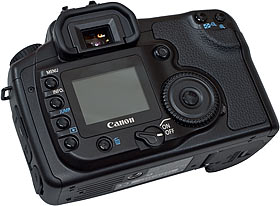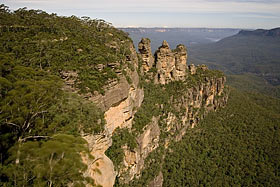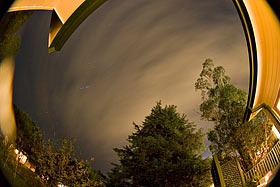
Strengths
Review date: 15 September 2005.Last modified 03-Dec-2011.
Generally, the 20D's Just Another DSLR.
It's not unusually small or light. Or quiet - it's actually got quite a noisy mirror-and-shutter mechanism, by DSLR standards. That's apparently what caught this beastie's attention.
It's got no spectacular one-of-a-kind features. It's up there with its price-bracket peers in important everyday departments like power-up and paparazzi mode shooting speed, colour accuracy, autofocus, exposure metering and sensor resolution (real resolution, not just pixel count), and it's got ticks in various boxes that matter to pro and semi-pro photographers (like support for Adobe RGB as well as sRGB). But there's nothing you can do with a 20D that's impossible with, say, a Nikon D70s or Minolta Maxxum 7D.
Canon's accessory list isn't that incredible, either (though there are plenty of third-party gizmoes as well). A full range of lenses, good but not amazing flashes, all the usual cables and brackets and so on, but nothing to seriously excite non-fanboys.
The 20D does have one significant, if not world-shaking, advantage over the competition, though. It's in the same department as various previous Canon DSLRs. Noise.
Top-quality digital cameras already beat the pants off film as far as image noise at high sensitivities goes, and not everybody cares much either way - but Canon have still been leading the charge to bring low noise to vaguely affordable hardware.
You can wind the 20D's sensitivity up to ISO 3200, if you toggle "ISO Expansion" in a config menu (otherwise, the max is ISO 1600, which is the highest sensitivity rating that exists for commercial colour film).
Surprisingly enough, ISO 3200 on the 20D is actually usable.
Digital cameras have had sensitivity adjustment for years, but in the olden days the higher ISO settings for any camera that cost less than a house were really, really noisy. So were long exposures. Long exposures at high ISOs - fuhgeddaboudit.
This 16 second exposure from my old DC120, back in 1999, was at the only sensitivity it supported - a miserable ISO 160.
Three years later, my new D60 did a 15 minute ISO 100 exposure (this) with pretty much no noticeable noise at all.
Low noise is a particular advantage of digital SLRs over integrated-lens digicams. Integrated-lens cameras (yes, well-informed nerds, except for this one) have much smaller sensors than you get in even a 1.6X-multiplier DSLR, and those smaller sensors, all things being equal, have to have smaller "photosites" on 'em, and this inescapably makes them more susceptible to noise.
The sensor of any digicam has its own native, real sensitivity - a real amount of sensor response per input photon. When you wind up the sensitivity, you're just telling the camera to multiply the numbers coming out of the sensor, so it'll pretend to have higher sensitivity than it really does. You multiply the noise as well, so the image gets grainier, but you get to use faster shutter speeds than you otherwise would. It's basically the same trade-off as you get with "faster" film, but with less complexity. Digicams let you change your "film speed" with the press of a button.
Progress is still, very definitely, being made, and Canon are just a tad proud of the way they do it.
This shot, taken while touristing through Jenolan Caves, just wasn't going to happen without a very high ISO setting. I took it handheld with my Peleng fisheye (I rather like what it does to things hanging from cave ceilings, don't you?), whose maximum aperture is f/3.5. That's actually better than the f/4 from the only auto-everything 8mm fisheye you can currently buy for EOS cameras (which costs three times as much, just like pretty much every other fisheye out there, including Nikon's unusual made-for-digital 10.5mm).
The wider the field of view of a lens, the longer an exposure you can get away with without using a tripod; magnify the image and you magnify vibration too. The rule of thumb is one-on-the-focal-length seconds, so a 50mm lens on a 1.6X multiplier camera shouldn't be used handheld with shutter speeds slower than 1/80th unless you want camera shake.
Even an 8mm fisheye on a 1.6X multiplier camera won't let an unusually steady-handed photographer use anything longer than 1/10th of a second. 1/15th is safer.
With the quite dim light inside the cave, 1/10th at f3.5 wouldn't cut it at some sensible ISO number, like 400. You'd need more like a quarter of a second.
But at ISO 3200, I could do a very comfortable 1/45th of a second, and still stop the lens down a bit (because the Peleng's rather fuzzy wide open; the various three-times-as-expensive fisheyes that don't look like Soviet tank parts are all much better optically). I could actually have gotten away with ISO 1600 for this shot and suffered a bit less noise pollution. But it's not bad as is - and this is without any further noise reduction filtering in Photoshop.
High ISOs are one thing low noise is good for; long exposures are the other.
It looks like a normal landscape shot, but if you examine the bigger version, you'll notice that some trees in the foreground are fuzzy; they waved in the breeze while the shutter was open.
This is a 30 second exposure, shot by moonlight at 2:37 in the morning, at f/3.5 and ISO 400. It's pretty much smooth as a baby's bottom, only partly because I used the 20D's long exposure noise reduction feature, which shoots a shutter-closed "dark frame" of the same duration as the exposure after the exposure's finished, then subtracts whatever it sees in the dark frame from the exposure, to deal with the noise characteristics of that particular sensor at that particular temperature.
Lots of cameras have this feature, but the 20D's cheaper ancestors didn't; they relied solely upon the inherently low noise sensor and its backing firmware. The 20D still has this in its favour, but it's got dark frame subtraction as well, for when you don't mind your photos taking twice as long. Frankly, there's seldom a lot of difference; the sensor's quiet in the first place.
But wait, there's more.
Back to that bloomin' fisheye. I use my novelty lenses, dammit (though not as well as some, I grant you).
This is an ISO 100 shot, again with dark frame subtraction turned on. And, once again, it's silky smooth (full-resolution version here), despite having an exposure time of 41 minutes, 37 seconds.
The longest internally timed exposure the 20D supports is 30 seconds, but all you need for outrageously long exposures like this is a remote shutter release. If you use Canon's own basic RS-80N3 remote switch (or one of the cheap clones of it that people sell on eBay; it's just a switch, so you should be able to buy knockoffs with confidence) then you'll need to meter exposure with a stopwatch (assuming you don't want to just wing it). There's also the rather more expensive TC-80N3, which has an integrated timer that lets you schedule exposures in various ways - though, annoyingly, it won't let you do an automatic sequence of different exposures. It'd be nice if your camera out in the garden could do 20 minutes, then 30 minutes, then 40 minutes, while you sit inside watching TV. Something homebrewed is clearly called for.
The major limiting factor for super-long exposures on the 20D is, I suspect, battery life. Old manual cameras don't have this problem (they may have a battery powering their light meter, but that doesn't matter), but if the 20D runs out of juice, it'll close its shutter and power down. I don't know whether it'll even do you the favour of saving the image.
Realistically, this won't be a problem for the vast majority of 20D users. One battery will last a long time, and if you use the BG-E2 battery grip (see the end of this page) you can use two batteries in parallel.
If you do manage to run 'em flat taking pictures of the sky or caves or whatever, there are ways around the problem, though. Various plug-and-go external battery packs exist; they're aimed at the big glass professionals, but there's nothing but their generally rather exciting price to stop anyone from using one. Alternatively, you could subvert an AC adapter cord (which, on the 20D and other EOS digitals, plugs into the camera via a dummy battery; the combo AC adapter and double battery charger has stayed the same since the D30, and there's also a chargerless adapter, the ACK-E2). Either run the AC adapter from a 12V pack and a little inverter, or plug the dummy battery straight into a hacked-together battery pack.
The biggest market for this sort of paraphernalia is astrophotographers. Real (or just decorative) star-shooting is possible with the 20D. Given the expense (in time or money) of many astrophotography rigs, not to mention the hassle of dealing with hypered film, DSLR astrophotography is an attractive prospect for a lot of stargazers.
You don't have to spend big bucks on top of the price of the camera. You can do astrophotography with a standard DSLR and various standard lenses (not necessarily big zooms), as well as with telescopes of various degrees of fanciness. To avoid star trails in long exposures, you can use a simple "barn door" mount. Astrophotographers commonly combine multiple shorter exposures to reduce noise, blending them using software later; the results from this can be spectacular (and you can make star trail pics this way too, if you like).
The standard 20D works for visible light shooting; if you want a camera that can see infrared, Canon have the EOS-20Da, which lacks the "hot mirror" IR-blocking filter and has some other tweaks (and comes with an AC adapter as standard). It's possible to convert existing cameras, too.
Oh, one more thing about night photography.
If you're interested in taking night shots with Canon's neat-o version II f/1.8 50mm, be advised that unlike the original version, the cheaper all-plastic version has no focus scale. There's no little series of graduations anywhere on the lens to tell you at what distance it's focussed.
At night, when you're doing long exposures of dimly lit things too far away to light up with the flash, you can't see enough through the viewfinder to focus. The result of this is that you won't even be able to focus on a landscape properly, except by trial and error.
How's that, I hear you ask? Surely you can just wind the lens out to its maximum focus distance, which will of course be infinity, and then photograph moonlit landscapes, or indeed the moon, to your heart's content?
No, you can't. Because camera lenses can usually focus a bit beyond infinity.
Focussing past infinity ought to show you a Place Men Were Not Meant To See. Tediously, what it actually does is make it impossible to take a non-fuzzy shot of anything. Lenses are made this way so that bits that're just not quite the right size or have been knocked a bit out of place won't leave the lens unable to make it to infinity at all. Thermal expansion and contraction might have something to do with it as well, but it's mainly a mechanical tolerance allowance - the "back focus" of a lens is the distance it expects the film/sensor to be behind it; the "body focus" of the camera is how far behind the back of the lens the film/sensor actually ends up. Lenses have to allow for differences in body focus distance.
Anyway - if you don't have a focus scale on your lens, and for whatever reason it doesn't happen to perfectly focus all the way to infinity on your camera when you just wind the focus all the way out, then you're going to have a very hard time using your camera in really low light conditions.
If you're using a camera like the 20D, which has very good low light autofocus (that's one of the things that Canon improved steadily after the D60, which was already pretty decent; low light autofocus was a bit of an "issue" for the D30), then you're probably not going to be able to focus manually in much dimmer light than the autofocus can handle.
Fortunately, most lenses do have a focus scale. It won't necessarily be exactly accurate - the focus scale's subject to the same tolerances that make it necessary for the lens to go past infinity in the first place - but at least it lets you repeat the same focus over and over. Snap a few pictures of, say, the moon (because that doesn't need a long exposure - the moon's lit by direct sunlight, so you use direct-sunlight exposures to photograph it), find which focus scale setting gives you a sharp image, and that's your infinity.
The rest of this review:
Introduction Resolution
Lenses Confusion
Alternatives
Review EOS-20D kindly provided by Dirt Cheap Cameras.
Australian digital camera shoppers should check out CameraStores.com.au.
Shoppers from the USA might prefer DealTime.





